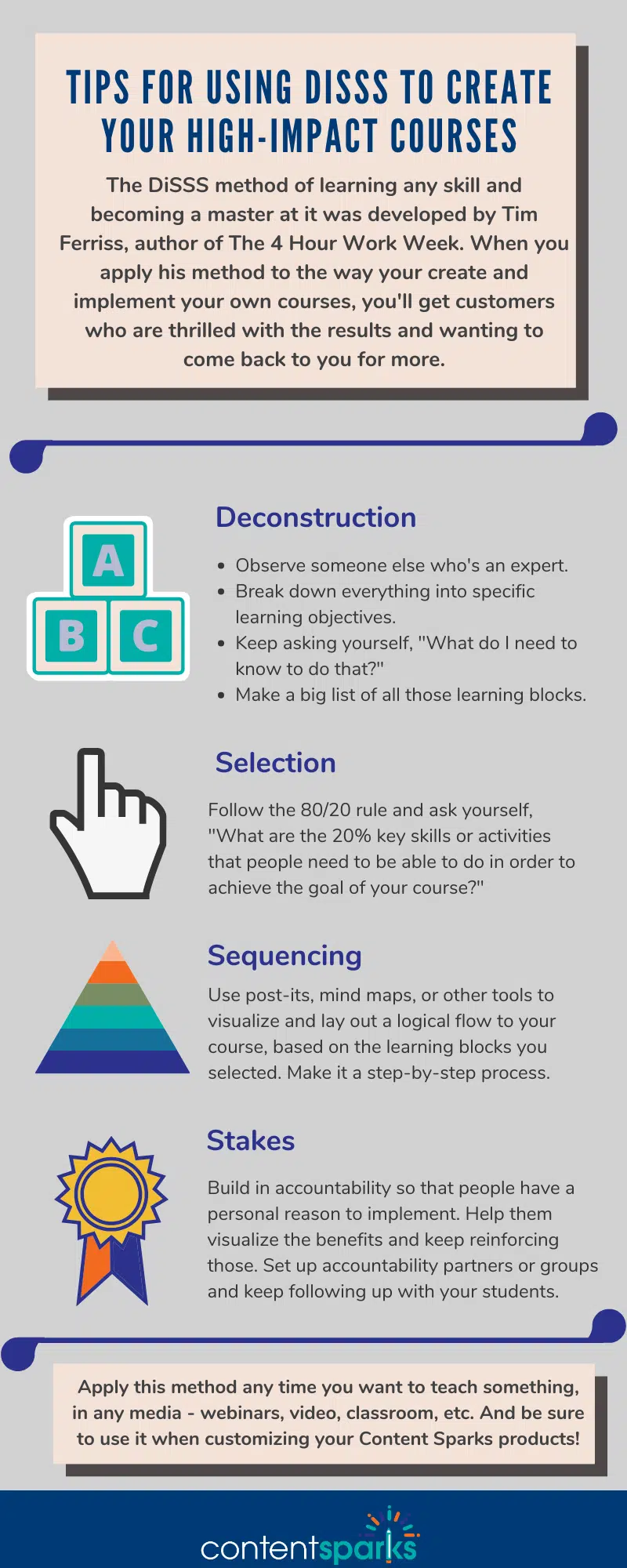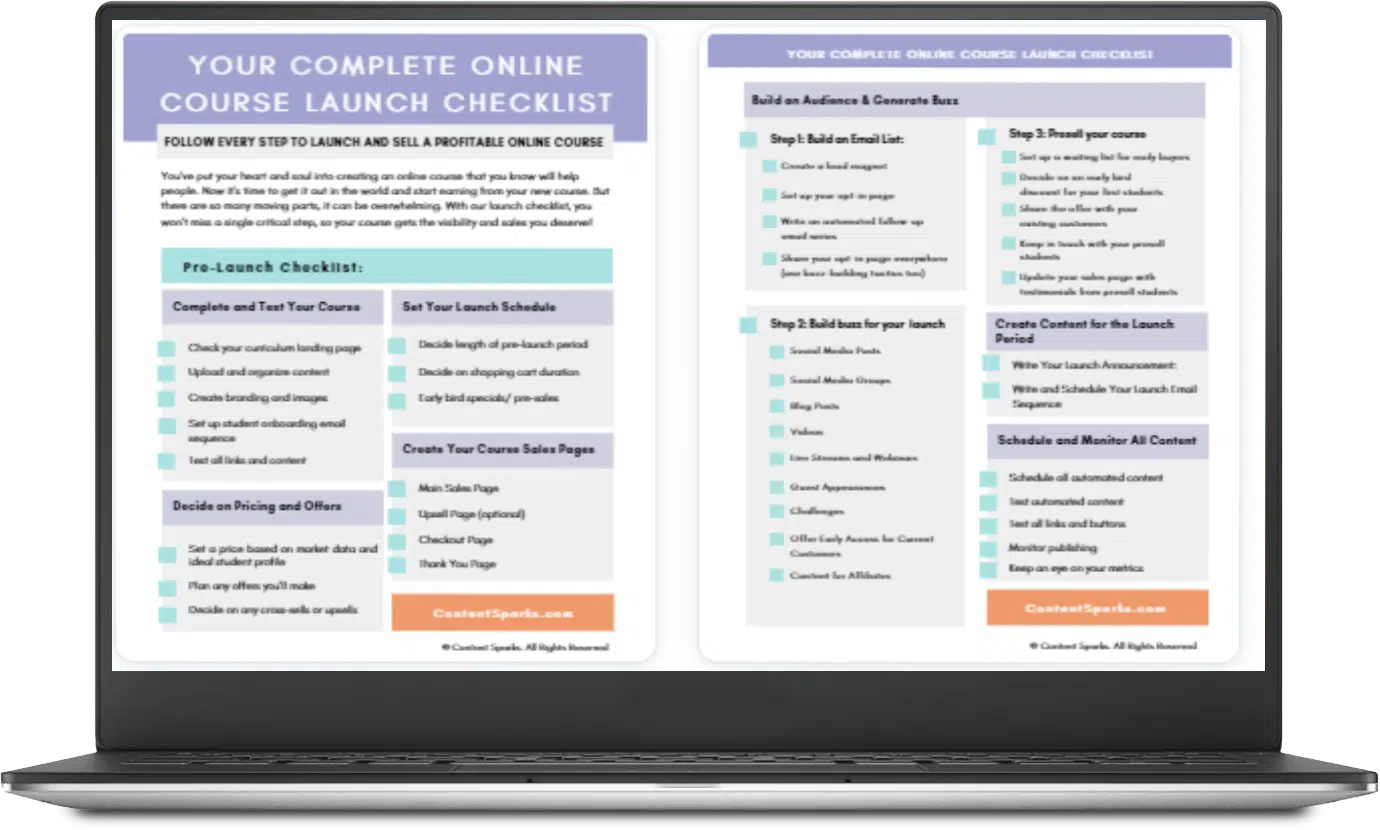Tim Ferriss is famous for many things: his books, his numerous businesses, and one of the top-rated business podcasts on Spotify.
I watched a talk that he gave about his famous DiSSS method of learning, during which he claimed that:
“It is possible to become world-class and enter the top 5% of performers in the world, in almost any subject within 6-12 months, or even 6-12 weeks.”
There are a lot of fantastic nuggets in Tim Ferriss’ work that coaches, consultants, and solopreneurs can learn from, but many gloss over one lying right in front of them: how to use his DiSSS method to create high-quality courses that make an impact and keep your customers coming back for more.
The DiSSS method isn’t just another hacky acronym: Tim's method bears all the hallmarks of good instructional design. At the same time, he's boiled it down to something that's easy to understand without having to study for 4 years and get a Master's degree.
Read on for an explanation of what the DiSSS method is, and how to use it in your online courses and infoproducts.

What is DiSSS?
The DiSSS method is a learning framework developed by Tim Ferriss for rapidly acquiring new skills. It stands for:
(Sorry, there's no ‘I').
This method is part of Ferriss's approach to accelerated learning, which he discusses in The 4-Hour Chef. In my own attempt to boil things down to the essentials, I'm going to go through each one and give a few tips for how you can apply them in your own courses, webinars, and other training for clients.
Deconstruction
Start by deconstructing the topic into digestible bits. For instance, ask yourself, “What are the minimal learning units, the Lego blocks, I should be starting with?”
In traditional instructional design, the Lego blocks are your learning objectives (or outcomes). You'll see those in each of our training programs here at Content Sparks.
There's nothing particularly eye-opening or new here, but most people have trouble identifying those learning units, especially if you already know a topic. It's easy to skip over something you take for granted.
It helps to observe someone else and/or ask them questions as they do whatever you're trying to teach. Otherwise, try working backwards and keep telling yourself, ‘ok, what do I need to know to do that?'
Now, list all those Legos in a nice, logical order. If you follow along with my guide to creating a course outline, some of this should overlap with the instructional design principles I shared there.
Selection
Next, eliminate the waste and focus on the essentials.
To do this, ask yourself, “Which 20% of the blocks should I focus on for 80% or more of the outcome I want?”
The Selection step is where Tim says you need to apply the 80/20 rule. This is part of the reason that Tim can learn things so quickly: he focuses on the most important elements of a topic first rather than getting bogged down in all the details.
This can be subjective, so if you’re stuck, ask yourself what the 20% key skills or activities are that people need to be able to do to achieve the goal of your course.
Make a big list of everything you can think of, starting with the deconstruction you did in the first step. Then remove as much as possible. The goal, of course, is to remove 80% of those blocks while still being able to achieve your end goal!
Sequencing
Now that we’ve eliminated all non-essential topics, it’s time to order your Lego blocks into a logical step-by-step list of topics for your course.
This activity is a central part of good instructional design, and it all follows from the deconstruction and selection you've already done.
If you're having trouble figuring out what order you need to follow to teach your content, try creating a visual flowchart or mind map.
A lot of people like to use post-its and just put them on the wall and reorder. That's how I used to do it when I worked with fellow consultants designing training programs. We put all the main learning blocks on post-its, put them on the wall, and stood back to look. Then we kept moving things around until it made sense.
When you have what you think is a logical sequence for your course, test it with people who don't know the topic well. If there are any speed bumps or points of confusion, then you know you might need to re-work the flow of your course.
Stakes
This hard work you’ve done is great, but you need to make sure that your course is taken by your students and that it makes an impact on them.
To get people to actually implement your training, Tim says they need real consequences – positive and/or painful.
This is where accountability partners or groups can help. By building accountability into your course, you can make sure that your customers take the time to work through it. It’s also where coaching can be a huge differentiating factor.
I'm not big on the avoidance of pain as a motivation, though I understand. It just reeks too much of childhood ‘time-outs'. That didn't work with my children, and it definitely won't work for me. However, when you make a commitment out loud to an accountability partner or coach, there's the pain and embarrassment of potentially telling them you didn't follow through.
Even better, how about a special treat for the incentive? Chocolate, anyone? Trip to Hawaii? I'd work pretty hard to learn something if I knew that was waiting for me!
Kidding aside, there always has to be a clear incentive for someone to follow through. If each of your learners can visualize exactly what they'll be like and the benefits they'll reap if they achieve your course's objectives, then you can keep directing them back to that visual.
TIP: Use the DiSSS method and the tips here when you're customizing any content from Content Sparks. Everybody's market will be starting with a different set of skills and knowledge. Take out the parts that they already know, or cut those down. Add in things that are missing.
And definitely try the post-it method if you're not sure how you want your course to flow. It's time-tested, proven, and colorful!

The Ultimate Online Course Launch Checklist
Use this checklist to take action with your online course today!
Why DiSSS Matters for Course Creators
Even though Tim Ferriss makes a living off of showing how entrepreneurship can be easy, even he’d admit it takes work to implement this the right way.
Worried you have too much work on your plate to add on a new method of creating courses to your to-do list? Here are four reasons to pay attention to the DiSSS method when designing your courses and info products:
DiSSS isn’t just another acronym to add to the pile, it’s a framework based on good instructional design that you can use to create courses that make a stronger impact and lead to a successful launch.
Creating a Course is Hard Enough: Download My Free Course Launch Checklist
Creating a great course is just one piece of the puzzle. Once you have that course ready, then you need to launch it.
For instance, you need to:
But if all this is making you break into a cold sweat, take a deep breath. I’ve got you covered. Click the button below to download my free course launch checklist. It’ll teach you how to do all the above and more to ensure your launch is a smashing success!

Tags